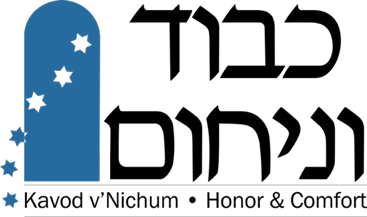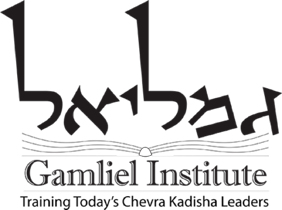An Overview Guide to Handling Jewish Dead
This guide is intended for those professionals whose work includes the handling of dead bodies (in Hebrew meit for a man and meitah for a woman), to provide an understanding of Jewish customs and expectations when a Jewish person dies. This document has the following sections:
- Overview of Jewish Customs
- Questions to be Asked of the Family
- Requirements Asked of the Funeral Home
- Recommended Personal Protective Clothing for Tahara
- Items to be Taken to the Cemetery for the Funeral Service
- Recommended Burial Shroud Sources
Overview of Jewish Customs
In Jewish tradition life is treated as a gift – given at birth, taken at death – the body then to be returned to the earth from which it came. Hence, it is normal practice for Jewish remains to be buried in the ground, not cremated or otherwise disposed of. Jews have special rituals to support the deceased, the family, and the community when death occurs.
During a person’s life, their body holds their soul. Thus the body is considered a holy vessel to Jews, and it is treated with utmost respect and dignity, both during life and after death. When a Jew dies, the body is prepared for burial through a specific procedure known as the Tahara that is performed by other Jews. This process includes washing the body physically, a ritual washing through the pouring of water over the body, the dressing of the body in tachrichim (burial garments) and the placing of the body into the casket.
Because the Jewish tradition includes the concept of soul, the body of the deceased is not left alone from the time of death until burial. A “shomer” (Jewish person guarding/accompanying the body) sits with the deceased and reads Psalms.
Part of traditional Jewish practice is to avoid embalming and autopsies if possible. However, organ donation is allowed. It is expected that if the body is cut open for either autopsy or organ donation, that afterwards openings will be stitched tightly closed so no fluids can pass into or out of the body. Also blood and any other body parts should be saved and returned along with the body. The Tahara procedure is usually performed a few hours before burial.
Questions To Be Asked Of The Family
- What is the full Hebrew name of the deceased?
- What is the full English name of the deceased?
- What should be done with the wedding band (if any), buried with the dead or given to the family? What about any other jewelry found on the body?
- Does the family want to participate in Shmirah? (Sitting with the casket, reading psalms.)
- Does the deceased have a prayer shawl (tallit)? Do the family members want him (or possibly her) buried in it?
- Any special requests?
Requirements Asked of the Funeral Home
A rabbi or Chevra Kadisha (Jewish burial organization) representative should be contacted immediately upon the receipt of the body and arrangements made for the Chevra Kadisha to prepare the body for burial by performing a Tahara, a procedure that includes a physical washing of the body along with prayers and ritual washing. The Chevra Kadisha will provide much of what is needed for this process, however we need your help in the areas listed below.
- The body should be lying on his/her back with eyes closed on a table that tilts with the table tilted downward just slightly toward the feet. The body should be covered with a clean sheet. All catheters in the body should be removed before our arrival, clothing should be left on the body. If jewelry is not removed before the deceased reaches the funeral home, it should be removed prior to the Tahara and returned to the family of the deceased. The body should always tagged with full name when received in the funeral home, and this tag should not be removed.
- The table on which the body is resting should be locked into position, both the tilt and the wheels.
- The casket should be in the room on a separate table. The casket should be simple wood, not metal or other material. It should have holes cut into the bottom, and be free of fancy linings or other embellishments.
- There should be a third empty table available in the room for spreading out shrouds and supplies, etc.
- Please provide a Jewish tachrichim set for the appropriate gender of the deceased. (See the recommended burial shrouds below.)
- Please provide jackets, aprons, or smocks for the Tahara team to wear (usually four to six people are needed). A supply of heavy-duty rubber or latex-free gloves (sizes XL and S) should be on hand. (See the recommended personal protective clothing below.)
- There should be at least 6 clean, dry sheets available (white, rectangular, twin-size).
- There should be plenty of clean cloth towels (at least 12) available and a roll of cotton batting or paper towels available as well.
- A water source should be close at hand – a sink big enough to fill buckets in, wash hands, etc.
- The room should have a working drain in the floor or near the end of the table on which the body is resting.
- An appropriate container for bio-hazardous material should be available in the room.
- There should be another trash can or laundry bin for used sheets and cloth towels.
- Arrangements should be made to turn off any buzzers, phones, alarms, etc., that are in the room where the Tahara takes place.
- Once the Tahara is completed, the casket with the body inside will need to rest in a different room from where the washing occurred so the deceased may be visited, and so the preparation room can be used for other purposes. The prepared deceased should rest in a place safe for a candle to be lit and have space for a person to sit near the coffin. Please make arrangements for family members or others to sit with the body until burial. This could easily be through the night or over a weekend. Some funeral homes provide low chairs specifically for this purpose.
- A qualified staff member should always be in the facility when a Tahara is being performed, should any problems arise that need assistance.
Personal Protective Clothing for Tahara
The following is a list of disposable protective items:
- Surgical gloves, various sizes
- Full sleeve coveralls (one-piece full-body suit, elastic sleeves, zipper, attached boots) or surgical gowns, waterproof and disposable
- Surgical shoe covers
- Surgical head covering
- Surgical face splash shields and face masks
Examples are the following available from allheart.com:
-
- Full sleeve gown (one size) (50) AH-D000260
- Skid resistant booties (100 pr) AH-D000320 (one size up to men’s size 10)
- XL booties (100 pr) CM-35
- Bonnets (nurses cap) (5 boxes of 100) CM37
- Anti-fog surgical masks (50) GM-1834
- Small latex gloves (100) AH-D000290 SM
- XL latex gloves (100) AH-D000290 XL
Items to be Taken to the Cemetery for the Funeral service
- Sound system and stand for speaker
- Podium for Rabbi
- Podium for register book
- Hand washing water and Laver [3 handled cup]
- Clean towel
- Umbrellas in case of rain [6]
- Blankets for family members in case of cold [6]
- Cold drinking water/cups if hot weather
- Kria Ribbons for family members to tear/wear
- Kaddish cards
- Rabbi’s card with pertinent information about the deceased
- Maps from cemetery to house of Shiva if needed
- Shiva prayer books to be returned to funeral home after Shiva
- At the gravesite, please ensure that there is a mound of dirt near the grave, and several shovels available. Part of the burial service includes family members shoveling dirt into the grave onto the casket.
Tachrichim (Burial Garment) and Casket Sources
- Burial garments and other supplies for a Jewish funeral can be ordered from the following sources. It is best to have a number of these on hand depending on the size of your community and the volume of Jewish funerals performed each year. We recommend ordering men’s size large and women’s size medium, linen is recommended. Each shroud comes in a box containing the following pieces (unless one-piece shrouds are ordered):
- Head covering [for a man] or bonnet [for a woman]
- Pants [Michnasayim]
- Shirt [K’tonet]
- Kittel [robe with collar]
- Avnet or Gartel, [a belt]
- Apron [for a woman]
- 2 bands to tie on legs
- Sack for loose hair and other items
- Sheet to go into the coffin
- Sources of caskets and burial garments:
Arkwood Caskets
Paul Fienstein
P.O. Box 3383
Ashland, OR. 97520
888-482-7135
Bais Moed
Rabbi I. Shimon
1441 – 52nd Avenue
Brooklyn, NY 11219
718-851-5114
Rose Solomon Company
63 Flushing Ave,
Unit 330
Brooklyn, NY 11205-1005
718-855-1788
For information about supplies the Chevra Kadisha group will bring to the funeral home click here.

